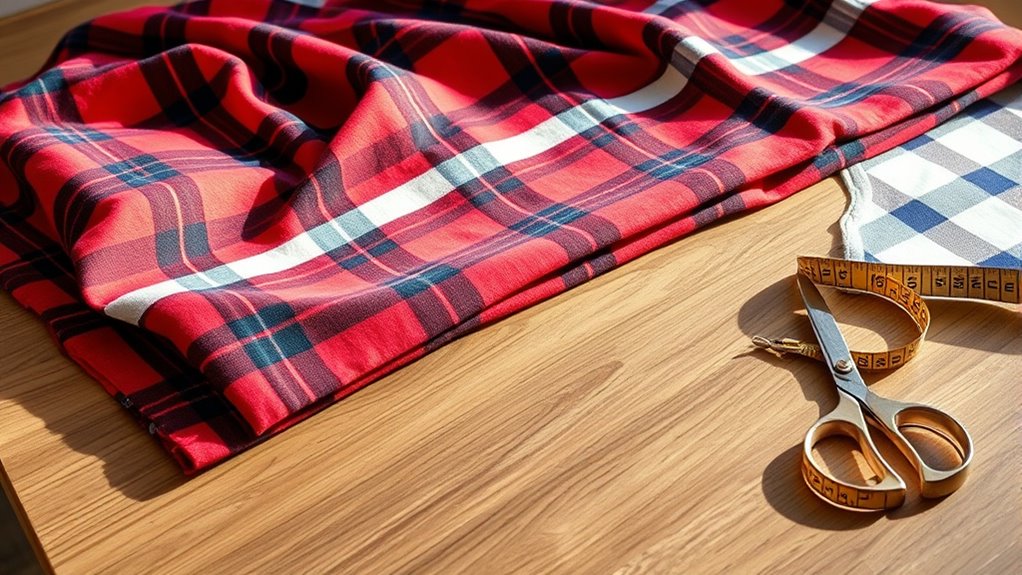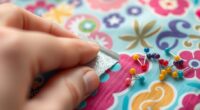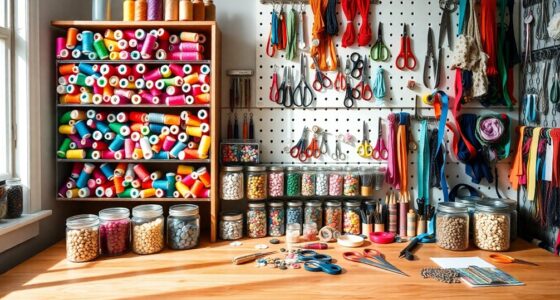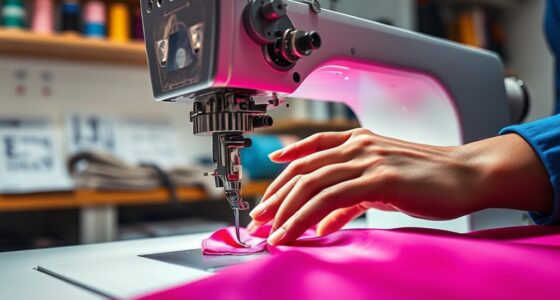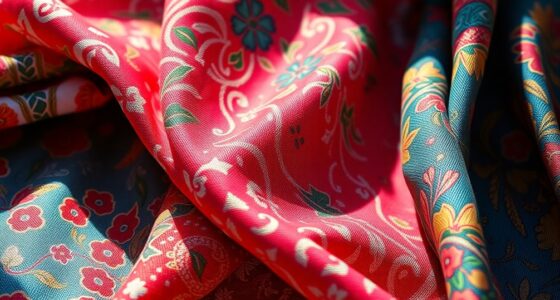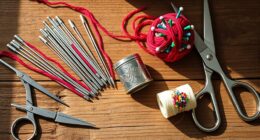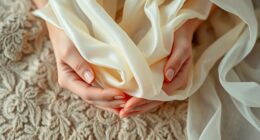To match plaids like a fashion house cutter, start with a dominant color in one piece to create cohesion. Pair patterns that share similar hues and vary their scale for visual interest. Use layered items thoughtfully, balancing bold plaids with solid colors or neutral accessories. Keep color palettes consistent and avoid overwhelming the look. With practice, you’ll develop an eye for harmony and bold combinations—continue exploring to master the art of plaid pairing.
Key Takeaways
- Choose a dominant color in one plaid piece to create visual cohesion across your outfit.
- Match patterns that share a common hue to ensure harmony and avoid clashing.
- Vary plaid sizes, pairing large-scale with smaller patterns for balanced visual interest.
- Incorporate neutral or solid-colored accessories to break up busy plaid combinations.
- Layer items thoughtfully, ensuring color palettes and pattern scales complement each other.
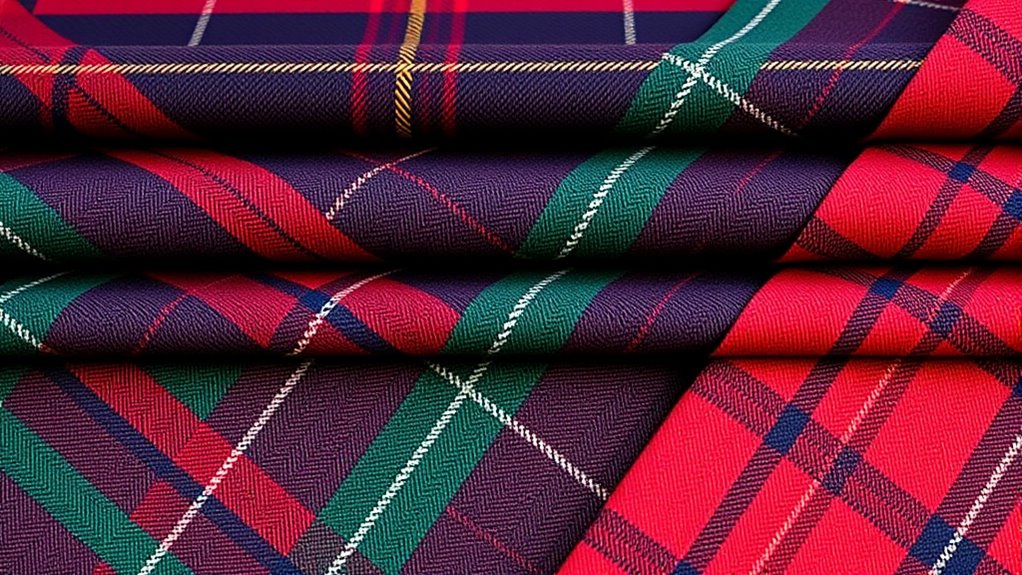
Matching plaids like a fashion house cutter might seem tricky at first, but with a few key tips, you can master the look effortlessly. The secret lies in understanding how to balance color coordination and pattern mixing. When you’re working with plaid patterns, it’s essential to contemplate how the colors in each piece interact. Start by selecting a dominant color in one of your plaid pieces, then build your outfit around it. This creates a cohesive look and prevents the patterns from clashing. If you’re mixing different plaid pieces, make sure they share at least one common hue. For example, pairing a navy and green plaid with a red and green plaid works because the green ties both patterns together. This approach keeps your outfit visually harmonious and avoids overwhelming the eye.
Start with a dominant color in your plaid to create a cohesive, harmonious look.
Pattern mixing in plaid outfits requires a delicate touch. You want the patterns to complement, not compete. One effective technique is to vary the size of the plaid patterns. Pair a large-scale plaid with a smaller, more subtle one. The contrast in pattern size adds interest without creating chaos. For example, a broad-checked shirt pairs well with a thinner, pinstripe plaid. Another tip is to keep the color palette consistent across your patterns. When the colors are similar, even contrasting pattern sizes look intentional and stylish. You can also introduce a neutral element, like a solid-colored jacket or accessories, to break up the patterns and give your eyes a resting point.
Layering is your friend when it comes to plaid pattern mixing. Overlap different plaid pieces, but be mindful of how each piece’s color palette interacts. For instance, a plaid scarf with a shirt or jacket can add dimension without overwhelming your look. Just make sure the patterns are scaled differently and share complementary colors. Remember, the key to pattern mixing is moderation. If your plaid pieces are bold and busy, balance them with simple, solid-colored garments. Conversely, if your plaid is subtle, you can experiment with more daring pattern mixes.
Ultimately, mastering the art of matching plaids involves a keen eye for color coordination and pattern mixing. It’s about creating a look that feels intentional and stylish rather than chaotic. Take your time to experiment with different combinations, trust your instincts, and don’t be afraid to break the rules once you understand them. With practice, you’ll develop an eye for pairing plaids like a true fashion house cutter, turning what seems complicated into a seamless, sophisticated style statement.
Frequently Asked Questions
What Are the Best Fabrics to Pair With Plaid Patterns?
When pairing fabrics with plaid patterns, you should consider fabric textures that complement the bold design. Soft wool or flannel work beautifully for plaid layering, adding warmth and structure. For a sleek look, try pairing plaid with smooth materials like silk or cotton. Mixing textures creates visual interest and balance, making your outfit stand out. Experiment with different fabric textures to achieve a stylish, cohesive look that highlights your personal fashion sense.
How Can I Match Plaids for Formal Occasions?
For formal occasions, you can elevate your look by pairing a classic plaid pattern with solid, sophisticated fabrics like wool, silk, or fine cotton. Consider the plaid pattern history for inspiration, opting for subtle, muted colors. Famous plaid designers, such as Burberry, often use timeless patterns that work well in formal settings. Keep accessories minimal and let the plaid statement be the focal point of your outfit.
Are There Specific Color Combinations to Avoid With Plaid?
When it comes to avoiding color clash and bad pattern mixing, steer clear of pairing plaid with overly bright or contrasting colors. Stick to a cohesive color palette, like neutral tones with subtle accents, to keep your look polished. Avoid mixing busy patterns with plaid unless you’re confident in your style. Instead, choose complementary shades and simple accessories to let your plaid stand out without creating visual chaos.
How Do I Choose the Right Plaid Size for My Body Type?
When choosing the right plaid size for your body shape styling, consider plaid size tips like opting for smaller patterns if you’re petite, as they elongate your frame. If you’re curvier, larger plaids can balance your proportions. For taller frames, medium-sized patterns work well. Focus on how the plaid complements your body shape, ensuring it enhances your natural silhouette while maintaining a balanced, stylish look.
What Accessories Complement Plaid Outfits Effectively?
Thinking about accessories is like adding the perfect sprinkles to your outfit—small details make a big difference. To complement plaid outfits, you should choose matching jewelry that enhances your look without overwhelming it. Opt for simple necklaces or earrings, and consider classic footwear options like ankle boots or loafers to keep your style cohesive. These touches will elevate your plaid ensemble effortlessly and keep your look polished.
Conclusion
Now that you know how to match plaids like a fashion house cutter, go ahead and experiment with confidence. Remember, variety is the spice of style, but balance is key. Don’t be afraid to mix and match, just keep the proportions in check. As the saying goes, “Fashion is what you buy, style is what you do with it,” so make your plaid combinations uniquely yours and own your look.
